Fascinating. I had no idea. I would've thought the last revenue steam engine would've been in the mid-60's at the latest.
Fascinating. I had no idea. I would've thought the last revenue steam engine would've been in the mid-60's at the latest.
In reply to T.J. :
Some of the last holdouts were Buffalo Creek & Gauley, who was all steam until they shut down in 1965. Denver & Rio Grande Western's narrow gauge lines never received any diesels, so they remained steam operated until the D&RGW abandoned them in 1970.
Crab Orchard & Egyptian is a weird one and is also arguable as the last steam railroad in the US, but I'd put an asterisk next to them, because they were formed as a vintage tourist line in 1971, operating over Illinois Central (actually Illinois Central Gulf at the time) rails. In '75 they bought an old Roberval & Saguenay 2-8-0, overhauled and planned to use it to haul passenger cars, but when a roundhouse fire burned down their passenger cars and then ICG stopped using the rails, they put the 2-8-0 to work hauling freight after it finished a 4 year ovehaul. They hauled freight with it, until a dry pipe burst in '86 and they retired it and replaced it with diesels. I put an asterisk on that one, as it was a tourist line that restored a steam engine to haul passengers, who then changed their goal and used it to haul freight. It wasn't like NWS&W, who used steam engines from the steam era into the 1980s.


CO&E did make for some weird photos though. A 1920s steam engine hauling modern hopper cars and piggyback intermodal cars is just weird.
Found video of the CO&E in operation. That's a good-looking engine. Pretty commanding sounding whistle too. The all-weather cab and clear vision tender are a tipoff of its Canadian heritage. It had a freshwater heater and a superheater when built but CO&E removed them for ease of maintenance. The strobe lights on the headlamp and tender deck were supposedly added due to some close calls at grade crossings. How the hell do you not see a steam locomotive approaching?
CO&E #17 is up at Boone & Scenic Valley Railroad these days, on display. It looks cosmetically tired, and I guess mechanically it is a "replace everything but the builder's plate" engine. In 1990, after the lease program with PRR #1223 and PRR #7002 ran out between the Strasburg and the RRMPA, they went to the B&SVRR to look at both locomotives they had on display, CO&E #17 and Norfolk & Western 4-8-0 #475. They determined the CO&E to be a basket case and bought the #475, which was only slightly better off mechanically.
In reply to 914Driver:
I actually had to go and do some Googling because its been a while since I've seen Back to the Future 3. But the BTTF3 engine at the end appears to just have a rather large cab on one end, not a Camel-type (Camel and Camelback were too different things, confusingly). And that cab happens to have gull-wing doors.

In reply to Duke :
They're pretty rare. B&O was really the only major proponent of them. The Camelback or Mother Hubbard won out in terms of popularity and mechanical superiority. The concept of the Camel was really just to put as much weight over the drive wheels as possible, although I imagine visibility was pretty great too. There is one, a B&O 4-6-0 preserved at the B&O Railroad Museum.

The Camel is not to be confused with Inspection Locomotives either. Those were like a conventional locomotive with a bus-like body dropped over them. They were usually pretty small and light, frequently only had one driven axle, and were intended to take officials out on inspections.

Those are also pretty rare. There is only one of them preserved, Reading's "Black Diamond" 2-2-2, which is tiny. Another, Lehigh Valley's "Dorothy" almost made it. It was retired by the Lehigh Valley, sold to a private individual, passed through 2 more private owners, the last of which actually ran it on track that he laid around his estate, and then got cut up in a WWII scrap drive. Particularly tragic, because no Lehigh Valley steam engines were preserved and this one was that close. From a historical preservation standpoint, a lot of history was lost with those scrap drives. Church bells, Civil War era cannons, WWI weapons and tanks, steam locomotives, even the USS Oregon (the last pre-dreadnaught US Navy battleship from the Spanish-American war)
In reply to NickD :
The scrap drives ate up a lot of the brass and nickel era cars I work on. Some of those tiny manufacturers only made a handful of cars and there may be only one or two left now. There's only two H.A. Moyer Runabouts known to exist and one of them is in our shop.
There was a fellow who saved some of the big cars back in the day. He had a huge pole barn and was known for putting a chain on the bumpers of the cars and hoisting them up on end for storage. We had a Stoddard Dayton town car that was the very car used by Stoddard for the Detroit Auto Show. It still exists because this eccentric fellow decided to hide it away.
Private people with money are the ones who save history. Museums rarely have the cash to do it but they provide a venue for others to view history.
In reply to ShawnG :
And now, a lot of scholars look back and say that, aside from the morale effect, those scrap drives really didn't contribute that much to the war effort. And now I'm off to Google to see what a Stoddard Dayton is.
The Stoddard-Dayton I mentioned:
It's the only town car and is now in the hands of the premier Stoddard-Dayton expert in the USA for a correct restoration.
Talking about the many missteps of DL&W #565, the near preservation of a DL&W Pocono, Strasburg nearly buying CO&E #17 and the Lehigh Valley inspection locomotive that nearly survived brings up the interesting topic of "Preservation Near Misses". Some of these are pretty well-confirmed, others stray into urban legend territory.
As mentioned, nearly everybody and their brother on the East Coast almost restored Delaware, Lackawanna & Western #565. Also, when retiring their steam locomotives, the DL&W set aside one of their 4-8-4s, which they called a Pocono, to donate to Scranton, PA (where they had their big shops, a roundhouse and a huge station). The DL&W was thinking more along the lines of building a small spur in Scranton and parking it on that and then removing the switch, but Scranton wanted the DL&W to disassemble the engine, truck it up the hill to Nay Aug Park and then reassemble it. Oh, and Scranton didn't want to pay for it, supposedly. The DL&W said "F that" and cut the Pocono up. And thus, no large, modern DL&W engines survived, just little #565 and a camelback 4-4-0.
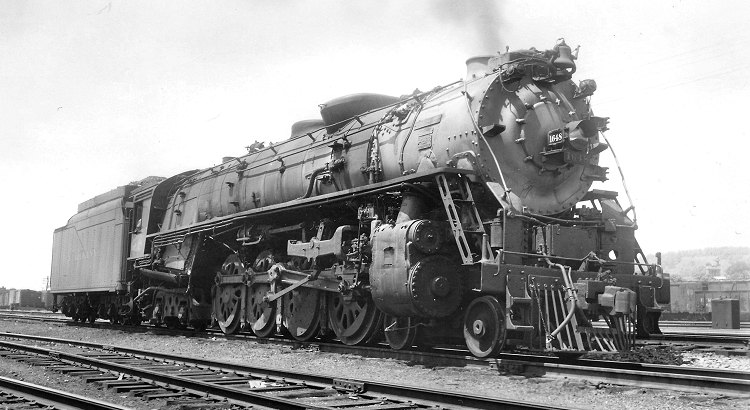
Similarly, the Lehigh Valley offered up one of their 4-8-4s, which they called a Wyoming, to Sayre, PA, where they had their big shops and yard. Sayre turned it down and the Lehigh Valley cut it up. And, after the scrapping of inspection locomotive "Dorothy" in WWII, now no Lehigh Valley steam locomotives of any size or era survive.
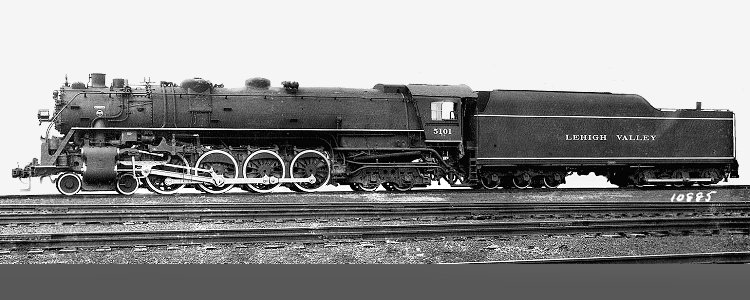
New York, New Haven & Hartford had cut up all of their steam engines, except for 3 Mikados that they were using to melt snow at their big terminals. They cleaned one of them up for use in a 1959 film and then by 1960 retired them all from even snow melting duty. The New Haven repeatedly offered them to multiple towns, two seperate trolley museums and a private owner and all of them turned them down. Only after they went to PA to be cut up did the owner of the Danbury Fair express interest and by then it was too late.

Frustratingly, the same exact thing would happen around 20 years later. When Conrail retired the last New Haven EP-5 Jet electric, they wanted to have it set aside. Funds were raised to preserve it, but then the railway location it was to be displayed at turned it down, "Nope, too new for us" and no other sites would accept it, and the last of the big New Haven electric motors went to the cutting torch.

Milwaukee Road tried to offer one of their awesome streamlined Hiawatha 4-4-2s to the National Museum of Transportation, but at the time, the NMoT was on a very small site and was just trying to collect one engine of each wheel configuration. They already had an Atlantic in Chicago & North Western #1015, so they turned it down. No word on if they offered a Hiawatha 4-6-4, but NMoT had a Nickel Plate 4-6-4, so the end result likely would have been the same. No Hiawatha steam locomotives survived.

I'd always heard that PRR, a railroad with an excellent preservation track, did not preserve any of their excellent J1 2-10-4s because they were a C&O design and not a PRR design. But there are those that rumor that 3 J1s were on company property until 1960 and one of them was supposed to go to the Northumberland collection, which was the engines they donated to RRMPA. These rumor states that PRR cut up the first two to get them out of the way and went to move the third engine to Northumberland, to await delivery to a museum, and it derailed 3 times in the yard and the crews just viewed it as a waste of time and cut it up on the spot as well.

The UP Big Boy gets credit for being the biggest steam engine, but the DM&IR 2-8-8-4s were heavier, the C&O H8 2-6-6-6 was more powerful and the N&W Y6b 2-8-8-2 made more tractive effort. There are preserved DM&IR Yellowstones and C&O H8s but no N&W Y6bs. There is a less powerful Y6a, but the last Y6b was cut up in '74. #2174 hauled a Farewell To Steam excursion in '58 and was the last big steam engine on the N&W. From there it went to a Roanoke scrapyard. The scrapyard owner was a steam engine fan and kept the #2174 around in the yard instead of cutting it up. He eventually worked out a deal with a historical society where they would raise the money and he would sell it to them, and he wouldn't scrap it before then. But before the funds could be fully raised, the old owner died, a new owner stepped in and he was much less patient, refused to honor the old agreement and had the #2174, the last Y6b, cut up in '74.

On a more cheerful N&W note, three of N&Ws Class A 2-6-6-4s were sold to Union Carbide for use as a stationary boiler. When they were retired, Nelson Blount, founder of Steamtown, came down to purchase one of them. When he got there, two of them had been torched to pieces and the last had some damage. He managed to spare the last one, and took parts from the remains of the other 2 to fix the last one. That Class A, #1218, would then be restored and operated by Norfolk & Western/Norfolk Southern for years before being retired.

Supposedly, for years, Southern tried to buy Grand Trunk Western 4-6-2 #5629 off of Dick Jensen to convert into a Southern Ps-4 replica. Jensen refused to sell, and after a prolonged legal battle with Metra, the #5629, an operational engine, would be cut up where it sat in the old Blue Island yard. Dick Jensen also purchased a NKP Mikado from a scrapyard but then never made arrangements to move it and essentially left it there to get cut up.

Bessemer & Lake Erie 2-10-4 #643 was nearly bought by Nelson Blount, who wanted to display it at Steamtown USA in Bellows Falls, VT. He lost in a bidding war to another gentleman. In the long run, this probably worked out for the best. The owner, a Glenn Campbell, took pretty good care of it as long as he could, and it has now been sold and moved to Age Of Steam Roundhouse to be cosmetically restored. If Blount had won it, it would likely be languishing outside at Scranton these days.

Nashville, Chattanooga & St. Louis #576 was considered for operation by Southern in their steam program. Nashville refused to let go of it. Then in the 1970s, Clinchfield considered it for their excursion program. Again, Nashville refused to let go of it, and Clinchfield went and got C&O #2716. Twice the #576 was lmost restored. Now it's being restored to operate on the Nashville & Eastern

George Hart repeatedly tried to purchase Central New Jersey #774, a Camelback Ten-Wheeler, the last steam engine to operate on the CNJ, but first couldn't raise the money and then when he finally did, it was too late and he had just missed her. The #774 was already at the scrapyard and being torched. He also tried to purchase a Reading G3 Pacific and got nowhere with it.

Sandy River & Rangely Lake was a Maine 2-foot narrow gauge operation that closed up shop in '36. A railfan plunked down all of his cash to purchase #24, a tiny 2-6-2. But after purchasing it, he realized he no longer had the money to move it, or a place to store or display it. And in '36, there weren't really any museums or preservation groups. So a year later he cut it up for scrap. Nothing remains of the SR&RL now.
In reply to NickD :
I'm just checking in on this thread after some absence, and the Amtrak / Northeast Corridor stuff is very interesting. I see these trains daily, and have ridden on them numerous times. Haven't had a chance to ride the Acela yet, but I see them frequently.
There is a stretch of NEC tracks that runs in a narrow strip of land between the Delaware River and I-495, which bypasses east of Wilmington, DE as it runs between Baltimore and Philly. Even the standard Amfleets take it at a pretty good clip, and the through-running Acelas can haul serious ass along there.
In reply to NickD :
I've seen the Aerotrain [edit: I knew this, but neglected to mention it] in the metal at the NMoT west of St. Louis back in 1988-89. Not sure if that was the small site or the big site (if it was the big site, the small site must have been a postage stamp).
Even sitting inert and long past its day under grey overcast skies, that thing looked like The Future. It has a very real presence.

For the last major design project of my architectural graduate school, we did a new home for the NMoT in the nearly abandoned rail yards just south of the Arch. I-70 stays elevated there for a mile or two after crossing the Mississippi. My design had a visitor center at grade on the east end of the site, near the river, and a long, sinuous cable-stayed bridge / ramp that gradually carried tracks up to the level of the adjacent I-70 skyway so passing cars could see it. Much like the Brooklyn Bridge there were pedestrian walks that allowed you to walk alongside, above, and underneath the displayed motive power and rolling stock.
It was totally unworkable even with a Corps of Engineers budget (let alone for a marginal history museum) and I got a mediocre grade on it. But the model section of it that I built looked awesome.
In reply to Duke :
So that thing is a GM Aerotrain. Its weird that it was specifically called a GM Aerotrain and not an EMD Aerotrain (EMD is/was GM's railroad division). Chuck Jordan (the guy behind the '59-'60 Caddy, the Opel GT and the Buick Reatta) styled it, and the coaches are actually 40-seat GM bus bodies. They were semi-permanently coupled trainsets, with the end of each car sharing a truck with car adjacent to it, and then a streamlined LWT12 power car (which was a regeared SW1200 switcher in disguise). GM tried to sell them to Santa Fe, Pennsylvania, Union Pacific and New York Central and none of them were really impressed. They were underpowered, rode poorly (in that era, the railroad manufacturers were convinced "lightweight" mean "excellent ride", which was not true), were hard to maintain and the inflexibility of semi-coupled trainsets was a hassle.
Rock Island ended up buying a single LWT-12 power car new but they instead went to American Car & Foundry for Talgo II lightweight trainsets. They then ended up buying the two Aerotrain demonstrators at an extreme discount and ran them in commuter service until '65.
In reply to NickD :
I can't recall if you've covered them already, but if not do you have an info on the Turboliners Amtrak ran in NY in the 70s and 80s? I'm pretty sure that's what I got to drive for a few miles when I was a kid (security precautions were not what they are today).
NickD said:In reply to Duke :
So that thing is a GM Aerotrain. Chuck Jordan (the guy behind the '59-'60 Caddy, the Opel GT and the Buick Reatta) styled it,
I knew that, I just forgot to mention it.
and the coaches are actually 40-seat GM bus bodies.
I did not know that, but as soon as you say it, it's obvious.
Rock Island ended up buying a single LWT-12 power car new but they instead went to American Car & Foundry for Talgo II lightweight trainsets. They then ended up buying the two Aerotrain demonstrators at an extreme discount and ran them in commuter service until '65.
I did not remember that anyone ever actually ran them in real service. Thanks!
Some other "near misses":
At one point, Hagerstown, MD offered up Western Maryland #202, a nice Pacific, to Strabsurg for $1. This story comes from the now-Chief Mechanical Officer of Strasburg. He said he was very junior at the time, so he doesn't know what strings were attached, but Strasburg turned it down, which he said was "Strasburg's top 10 boneheaded moves." The acquistion of WM #202 would have drastically changed the trajectory of Strasburg motive power. They would have never leased PRR #7002 (either a good thing or a bad thing, depending on which side you're on) and they likely would not have bought Norfolk & Western #475

Also over the years Strasburg also checked out a number of other engines, including PRR G5s 4-6-0 #5741 and PRR H6sb 2-8-0 #2846 (mid-'60s) Buffalo Creek & Gauley 2-8-0 #4 (1970s), Crab Orchard & Egyptian 2-8-0 #17 (late 1980s), Florida East Coast 4-6-2 #148 (also late 1980s) and Long Island Railroad G5 4-6-0 #39. Interestingly, Strasburg is now restoring LIRR #39 for the LIRR Museum, with a 49 year lease to operate. And FEC #148 just came off an insane restoration down in Florida.


Black River & Western eyeballed both Long Island Railroad (PRR) G5 Ten-Wheeler #35 and Bonhomie & Hattiesburg Southern #250, a quaint 2-6-2 Prairie, but neither of those panned out for whatever reason.


Louisville & Nashville offered one of their Big Emmas, the largest and most expensive Berkshires ever built, to the Kentucky Railroad Museum. But KRM didn't have much room, already had two L&N engines (Pacific #152 and 0-8-0 #2152) and a Berkshire (C&O #2716) so they turned it down and it was cut up for scrap, although two tenders from Big Emmas survived.

KRM was also given the offer to buy Illinois Central #2613, a 2600-series Mountain, which had hauled the L&N's Centennial train, as well as being the last Illinois Central steam locomotive to be in operation. IC never donated engines, but instead sold them, in hopes that a town or museum having money invested would lead them to take better care of the engine. KRM didn't have the money, so the #2613 was cut up for scrap. This meant that while there are 2 2500-series IC Mountains (which were converted from old 2-10-2s), there are no clean-sheet 2600-series saved

Baltimore & Ohio was the railroad that invented the articulated steam engine, and they kept tinkering and tinkering until they ended up with the EM-1, a hefty Yellowstone-type 2-8-8-4. None of them survived, but an old B&O Railroad Museum pamphlet lists an EM-1 as an upcoming exhibit. How is that? Well, B&O set #7600 aside in a yard to eventually be cleaned up and sent to the museum. The yard crews took to tinkering with it and cleaning and polishing little bits. One day, they yardmaster, who was out of the loop, heard that company brass was coming to the yard and he saw the old steam engine sitting in the yard and panicked and thought he was going to get in trouble for having old junk laying around the yard, so he ordered the crews to start torching her apart. Supposedly there was news footage of distraught-looking crews cutting the connecting rods that they had just been polishing hours earlier. This is all definitely confirmed but some versions also mention that there was a T-3a Mountain and a "Big Six" 2-10-2 there as well that were also destined for preservation and were cut up, but that bit might be straying into urban legend territory. But the EM-1 was real.

Missouri Pacific donated a 2-8-0, the #124, to Dupo, Illinois to display. To the MoPac's horror, the city cut just the front of the Consolidation off and mounted it against the wall and torched the rest.

Nickel Plate held an ex-Wheeling & Lake Erie-owned USRA Heavy Mikado in reserve to donate to Canton, Ohio. But Canton wanted a Brewster-built steam locomotive instead, so NKP gave them an ex-W&LE 0-8-0 switcher and sent the Mike to the scrapyard. And with that, no other USRA Heavy Mikes were saved.

Erie is another one of those railroads that saved no steam engines. They supposedly set aside two of their Pacifics to be sent to be preserved. One engine was then sent to Korea after the Korean War instead, to help rebuild their railroads, and existed for some period of time. This much is true, although whether it still exists or not is a large debate. Diving even more into urban legend, the second one set aside ended up getting cut up for scrap to get it off the tax roll instead.

Now here's a somewhat confusing one: When the 1976 American Freedom Train was being planned, Ross Rowland wanted to use NKP #759, a Berkshire that was owned by Steamtown USA. The engine had been shopped by NKP shortly before dieselization and held onto as possible reserve power, then sold off without ever seeing use. Ross Rowland leased the engine to run excursions and used it for his 1969 Golden Spike Limited, being very fond of the #759. It would suffer freeze damage in '75 and been taken out of service, and Rowland still felt it was the best choice for the AFT if repaired. But he was overridden and instead Southern Pacific "Daylight" #4449 was chosen and restored for operation. Then there was the realization that #4449 would not meet height clearances on many of the eastern routes and a second engine had to be found. So Rowland led the charge rescuing Reading T-1 #2101 from a scrapyard where she had sat for a decade and led an insane 30-day overhaul, taking her from junkyard dog to operational engine in the old Reading shops in a feat not since equalled. And then Texas got in on the act and insisted on using a Texas engine on the Texas segment, and restored Texas & Pacific #610. So, while it meant #759 would never be operated again, we did get #4449, #2101 and #610 out of the deal.




And finally, everything to do with Paulsen Spence and the Louisiana Eastern. That's a whole 'nother post, but the short of it was that Paulsen Spence acquired 40+ steam locomotives in the late '50s, and only 4 ended up escaping the cutting torch. And there was some raaaare stuff in that collection.

So, I last mentioned Paulsen Spence and the Louisiana Eastern Railroad. Just who was Paulsen Spence and the Louisiana Eastern and what happened to it?
Hans Paulsen Spence was born in Baton Rouge, LA in 1895. He went to LSU and graduated with a degree in mechanical engineering in 1916, and then went on to serve as a Lieutenant in the US Army during WWI. After returning from the war, he began developing devices important for the regulation of steam. While filing for his first patent in 1926, he got involved with the Rider-Ericsson Engine Company (founded by Captain John Ericsson, inventor of the screw propeller and builder of the Civil War ironclad USS Monitor) and inked an agreement to sell his designs through Rider-Ericsson. By 1939, with over 60 patents to his name, Spence's own designs were outselling anything Rider-Ericsson produced and he bought out the company and renamed it to Spence Engineering Company (still exists today in the same site in Walden, NY). Paulsen Spence would also go on to earn the Army-Navy "Type E" award (Excellence In Production), as well as have components of his design used in both the White House's steam heating system and the USS Nautilus, the first nuclear submarine. Incredibly intelligent guy who you never hear about.

After WWII, Paulsen Spence was incredibly wealthy and his day-to-day responsibilities with Spence Engineering were diminishing, so he looked around for other business opportunities. And 50 miles away from his home in Baton Rouge, was an area along the Tangipahoa River that was rich in gravel and sand. At the time, Louisiana was a major producer of gravel and sand, and the Illinois Central had a daily freight called "The Rock Job" that went north from New Orleans with empty hoppers, which it dropped off at the various pits along the way, and then returned to New Orleans with full cars. So in 1947, Spence leased a large plot of land 1000 feet off the Illinois Central mainline, had a mine built as well as tracks, a yard and a spur. The operation was called Comite Southern, and the interchange with the IC was called Sharon Junction.
In preparation, he had purchased two steam locomotives in 1946 to begin operations with. The first was a 45-ton 4-4-0 built by Baldwin in 1918(!) for the Red River & Gulf, numbered 104. The engine had been used for the RR&G's passenger operations, until they had declined and were discontinued in 1928, at which point the RR&G had put the engine in storage at Long Leaf, LA. The engine was in terrific mechanical condition, with the the running gear in like-new condition, but it was missing some valves and gauges, either borrowed by the RR&G for other engines or stolen by vandals.

The other engine was an older (1909) but heavier (64 tons) 4-4-0 built by Alco's Schenactedy, NY plant as Mississippi Central #98. The #98 had been run by the MSC in passenger service until the railroad discontinued passenger service in 1941. The #98 had then been bumped to light duty, typically haulling work trains, before being put up for sale. Like RR&G #104, the MSC #98 was not operational at the time of Spence's purchase.

After purchasing them, Spence sent the engines to Illinois Central's McComb, Mississippi shops to be overhauled and returned to service in preparation for Comite Southern's opening. But IC took too long to get the engines into the shops, maybe because they were busy catching up with years of deferred maintenance from the Great Depression and WWII on their own engines and didn't want to waste time, space and men on two antiques for some guy. So, Spence had the #98 and the #104 moved back to Sharon Junction, and purchased an ex-Alabama & Vicksburg, ex-Mobile & Ohio, ex-Illinois Central 0-6-0 to fill in, renaming it and renumbering it to Comite Southern #10. While he would have Illinois Central employees down tinkering on the #98 and the #104 on weekends to get them operational, the CS #10 handled most of the mine's motive power needs, until 1951, when the engine was sold for scrap.
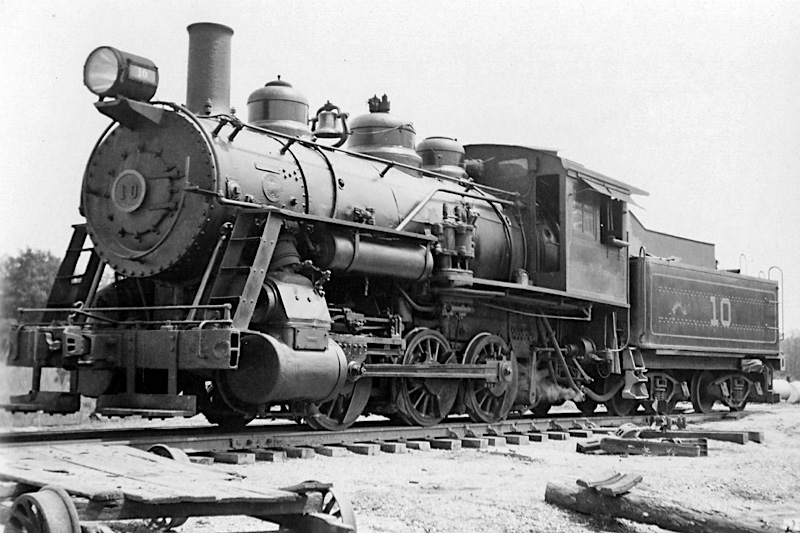
In 1948, he would also purchase a 1901-vintage Consolidation, #425, that had originally been built for the Colorado Midland, before changing hands and ending up on the Louisiana & Arkansas. The reason for this engine's purchase was that at some point it had been set up to burn oil, and Spence wanted an oil-burning engine on hand in the event that there was ever another lengthy coal mine strike, which seemed likely. The #425 was too large and heavy for the Comite Southern's rails though and was very rarely, if ever operated, and was scrapped in 1951, a tragedy because this was the last existing Colorado Midland engine. I did find a photo of it in a deadline with it's Louisiana Eastern number plate on the smokebox door and the old Colorado Midland number (#202) on the headlight number boards.

Ten miles south of Comite Southern was an even larger sand and gravel operation, the Gulf Sand & Gravel Company, along with it's 1-mile long railroad Gulf & Eastern. The G&E connected with the Illinois Central mainline at Shiloh, LA. The larger operation drew Spence's eye and he purchased the GS&G Co, as well as the G&E in 1950, moved the locomotives to Shiloh and closed down the Sharon Junction interchange. The G&E came with one 2-6-0, an old 1909-built Baldwin Mogul that had originally been purchased by the Louisiana Railway & Navigation, then sold to the L&A and then sold to the G&E. Like the #425, Spence would also scrap this engine in 1951, finding it too old and too light. The G&E was also laid with 55lb rail that Spence found too light for his tastes and replaced with used IC 90lb rail.

Spence now dove into some serious locomotive purchasing. He bought up both of the Gulf, Mobile & Ohio's Pacifics, the #581 and #582, as well as two GM&O Mikados, #475 and #485, and a GM&O 0-6-0 #45 and had them shipped to Shiloh. And while the Shiloh location was briefly operated under the Comite Southern name, he soon changed the name to Louisiana Eastern and renumbered Comite Southern #1 (ex-RR&G #104) to LE #1.
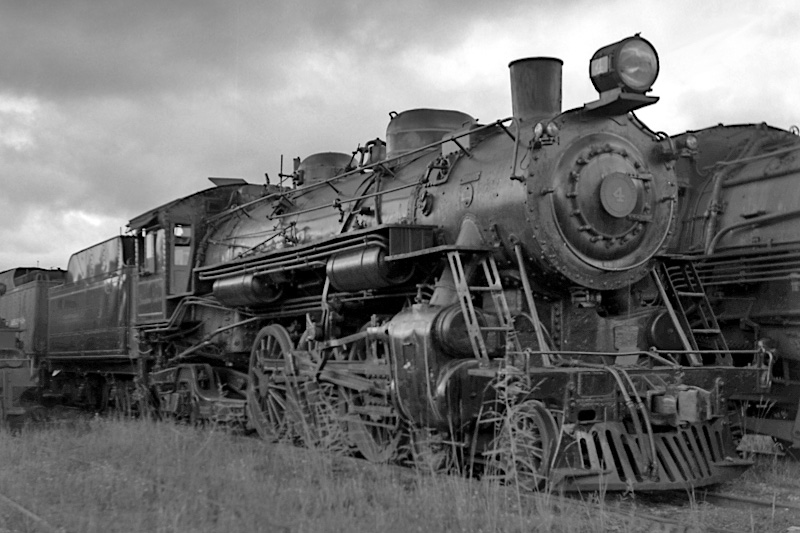

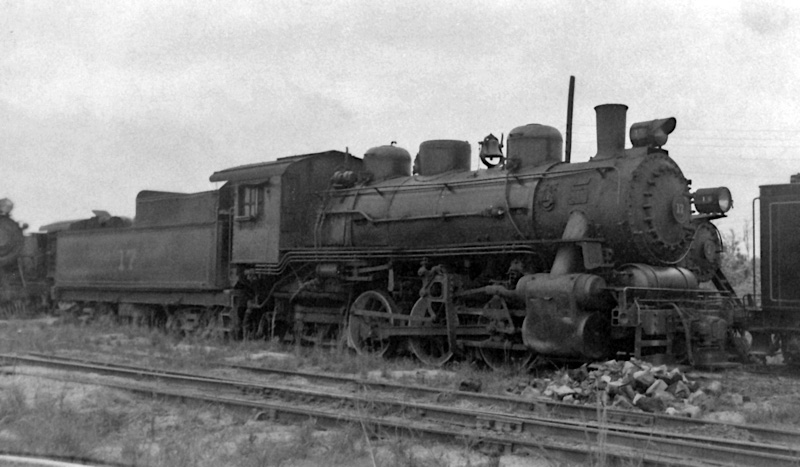
The Louisiana Eastern wasn't meant to just serve the old GS&G Co mines. No, Spence had big plans in mind. He wanted to connect Baton Rouge, LA and Pearl River, LA with 96 miles of main line and 24 miles of branch line, with the intent of serving other sand and gravel plants, as well as pulpwood producers. He also wanted to serve as a bypass to New Orleans for through-traffic. In the days before computer systems, freight cars very frequently were delayed when they became lost in large yards, as well as other delays just from congestion. The LE would connect with the Gulf, Mobile & Ohio RR, Southern's New Orleans & Northeastern RR subsidiary, Kansas City Southern RR's Louisiana & Arkansas RR subsidiary, Illinois Central and Missouri Pacific.
What was odd was that Paulsen Spence planned to operate the LE entirely with steam power. His reasoning was that, as railroads were dieselizing he could purchase steam locomotives secondhand for very cheap and that being that the LE would operate over flat ground, a heavy Pacfic or light Mikado could easily move 100 cars, so he wouldn't need more expensive or complicated 2-10-4s or articulateds. I imagine that seeing as how he made his money on steam regulation devices, he probably had a bit of professional pride on the line too.
He wrote to Southern Railroad to try and purchase 7 Mikados, 3 Pacifics and 0-8-0s, but negotiations fell through for some reason. He also tried to purchase 3 Missouri Pacific 4-6-2s, but found their asking price of $18k per engine far too steep. He would purchase three engines from the Texas & Pacific, 4-6-2 #700 and 2-8-2's #800 and #810. The 800 was notable for hauling the last steam powered passenger train on the T&P, just two years earlier.
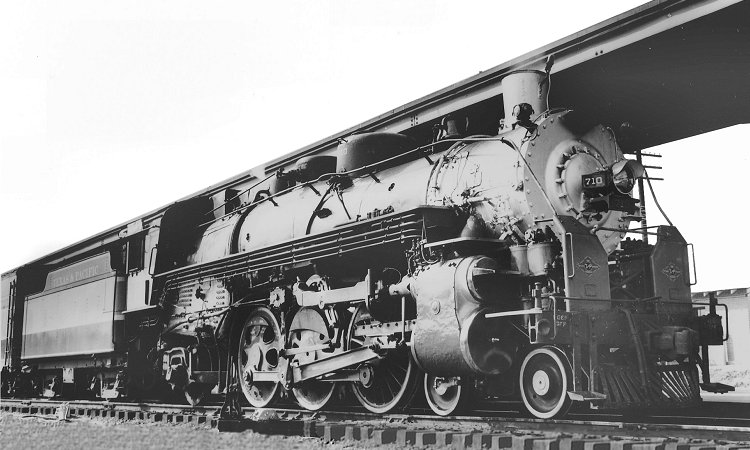

Paulsen Spence was apparently quite excited about these engines, writing to a friend " “Boy, I never wax eloquent about many things, but you never saw such engines in your life. They are U. S. No. 1 engines. There is nothing like them." And "Some son of a bitch stole the builders number off the 700. If you know who he is, you had better tell him to get it back or he goes to the Federal Prison. Few things in my life ever gave me more of a thrill than owning those engines.”
He also bought 3 Louisiana & Arkansas Lima-built Mikados, which were only 16 years old at the time, for $5800 a pop, giving him his newest and most powerful engines that he would own. Spence was apparently a big fan of Mikes, as he would own 12 of them, the most populous configuration on his rails.

By the end of '54, there were 20 steam locomotives parked at Shiloh. Along with the GM&O 0-6-0 he already had, he grabbed up two Texas & Pacific 0-6-0s as well, the #472 and the #478. He had also purchased two Mississippi Central Mikados, a third 4-4-0 from Southern Pacific, an Abilene & Southern light Mikado and an ex-Florida East Coast 0-8-0 from Louisiana & Arkansas.
In '54 he also purchased a big MSC heavy Mikado, which he renumbered to LE #16 and had the headlamp relocated to the top of the smokebox, a preference of Spence's. But it did not hang around long, before being sold to the Feliciana Eastern, a railroad operated by a friend of Spence's who needed to replace an ailing old IC Pacific. That is Spence himself in the cab of the engine in this photo.

Along with relocating the headlamp, Paulsen Spence loved renumbering the engines over and over, for no apparent reason. According to a friend and photographer:“Spence had as many renumberings as the Illinois Central did, possibly more. Every time you talked to him he had different ideas about what engines were to bear what numbers. Some engines have had as many as three different LE numbers. As soon as the men would get used to one set of numbers, Spence would come along and renumber them. No one ever figured out why.”
The application of the LE brass number plates made things confusing. The number on the plate was considered by Spence to be the locomotive's “official” number (even if a different number appeared elsewhere) and it was easy to change the front number plate. This leads to confusion about just how many engines Spence owned and their provenance, because it might appear as if he had more of one class than he did when he repeatedly renumbered the same engine. Someone said that Nelson Blount ended up with a boxcar full of LE number plates at Steamtown that he purchased from Spence's estate.
Spence was also buying large amounts of spare parts, and used rail and ties from every railroad that would sell them to him, to prepare for construction of the line. But by 1957, the line was still only 4.3 miles in length. It connected both of the Gulf Sand & Gravel loading sites and then went to the Shiloh interchange. A long ways from the 120 miles of track that he had proclaimed back in 1951. Only 2 locomotives (Abilene & Southern #20 and Mississippi Central #120) were in regular service although othern engines would also make appearances. Spence was also quite accomodating to railfans who wanted to come see his engines. Spence told one photographer that if he needed any engines moved to get access to another to just go ahead and move it himself. When the photographer explained he didn't know how to operate a steam engine, Spence reportedly told him "Well, now is the time to learn" and trained the man how to fire and drive a steam engine. Spence also operated a "passenger train" that went down to the end of the line and back, for free, on weekends.
Spence would also continue purchasing more steam engines. He bought 8 Illinois Central engines, two 0-6-0s, two 0-8-0s, 2 Pacifics (one of which was one of only 3 IC oil-burning Pacifics) and a lone Mikado.

From the Nickel Plate, he bought three of their powerful Hudsons, #173, #174 and #175.
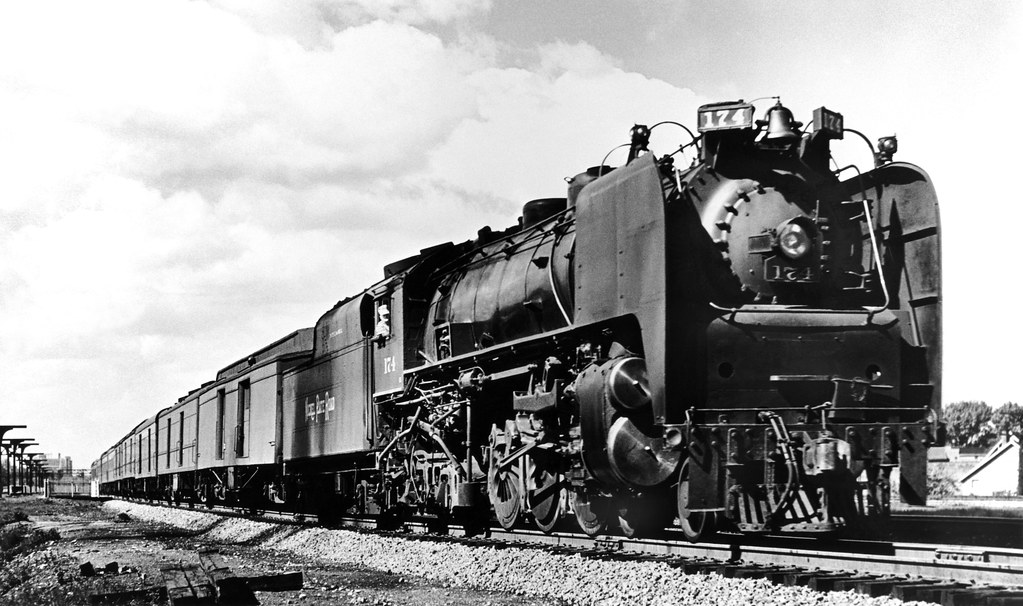
There were also 2 0-6-0s from the Grand Trunk Western (they only had about 9 of those, so pretty rare) and a Canton & Carthage light Mikado.
In 1961, Spence surprisingly sold off his two original steam locomotives. The RR&G #104 went to Stone Mountain Scenic Railroad in Atlanta, who dolled it up as a much older Civil War era engine. Mississippi Central #98 was shipped to Strasburg Railroad and renumbered Strasburg #98, but never operated there. These days, it's better known as Wilmington & Western #98 and was operational until very recently, now undergoing it's FRA 1472-day inspection.

Spence was also seeming to have a change of heart on the steam operation of the LERR. On October 29th, 1961 he admitted to volunteer engineer Wilbur Golson that he would not be riding the Sunday passenger train because he was tired, and that when the train returned he would be gone. He had to catch a train to New York City to purchase some diesel locomotives, as he had realized that he was going to have to face reality and operate diesels if he was ever going to get the LERR off the ground. He was planning to shuffle all the steam locomotives to the Baton Rouge Terminal trackage (a spur that he had purchased from the L&A but never operated) , once completed, and set up a museum with fan excursions, as he admitted to hating the thought of buying those big NKP Hudsons and never running them. October 31st, 1961, Paulsen Spence dropped dead of a heart attack, age 65.
Spence did intend to build a museum and his second will had set aside $400,000 to fund the creation of a museum with in the event of his death. But a legal technicality ruled the original will null and void and left the engine's fates hanging. Many preservationists, including Nelson Blount of Steamtown USA, scrambled to try and buy up the engines. One of Spence's daughters realized that these engines were worth more as pieces of history than they were as scrap metal, but Spence's wife and other daughter just wanted the fast paycheck from scrappers. Those who tried to purchase them were told they had 30 days to get the engines off the property, and the ICRR had torn up the interchange, so they would have to be disassembled and trucked out, which was just not feasible for 37 locomotives
In the end, only two locomotives escaped the end of LERR. The ex-Southern Pacific 4-4-0 went to Stone Mountain Scenic Railroad to join RR&G #104, also backdated as a Civil War era engine. And the GM&O #581 went to Pennsylvania where it passed through a few hands before ending up at Reading, Blue Mountain & Northern, who restored the engine to operation and still run the Pacific to this day,

With the scrapping of Spence's fleet, some real history was lost. GM&O #581 is now the only Gulf Mobile & Ohio engine left. W&W #98 is the only MSC engine left. There is only 1 NKP Hudson preserved. No Pacifics from Texas & Pacific or Illinois Central were saved, and T&P 800 was also the last steam engine on the T&P to haul a passenger train and was lost.

The Smithsonian's John H. White, Jr. has used Paulsen Spence as an example of what he calls “the impermanence of a single benefactor.”
In reply to 914Driver :
I don't know what it is about those Bombardier Bi-Level coaches, but I think they are just the ugliest things rolling.
You'll need to log in to post.